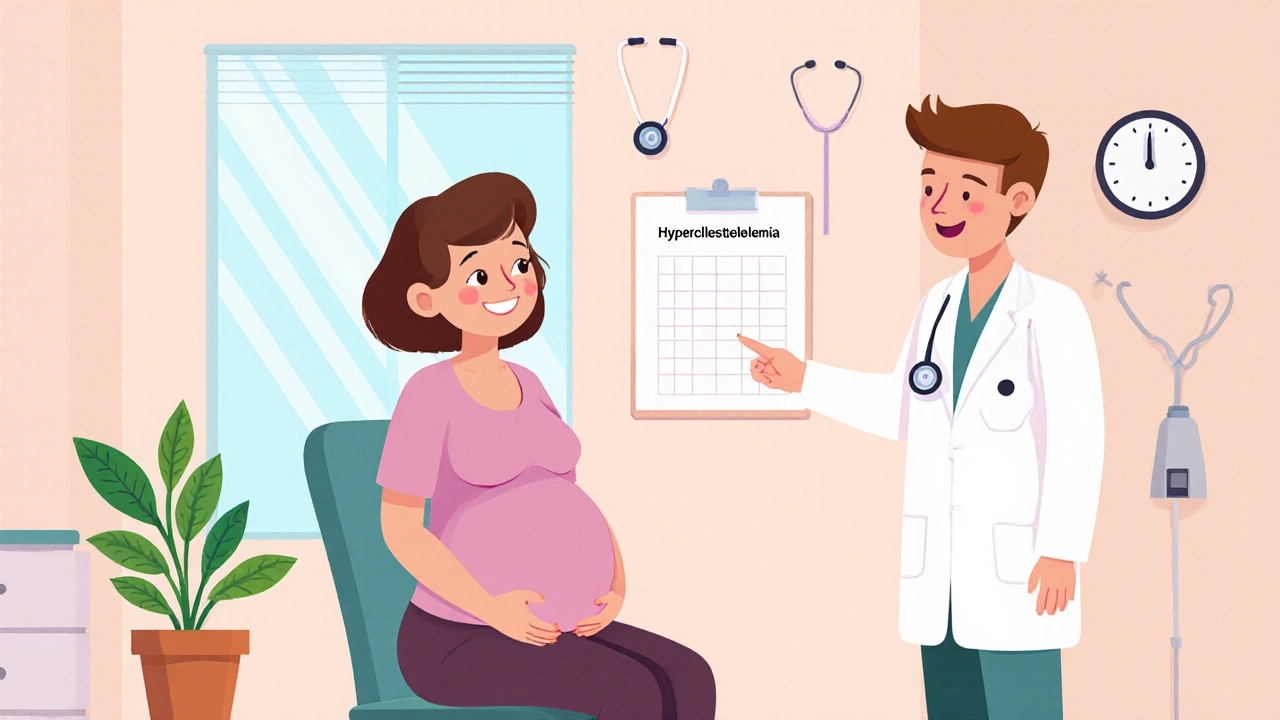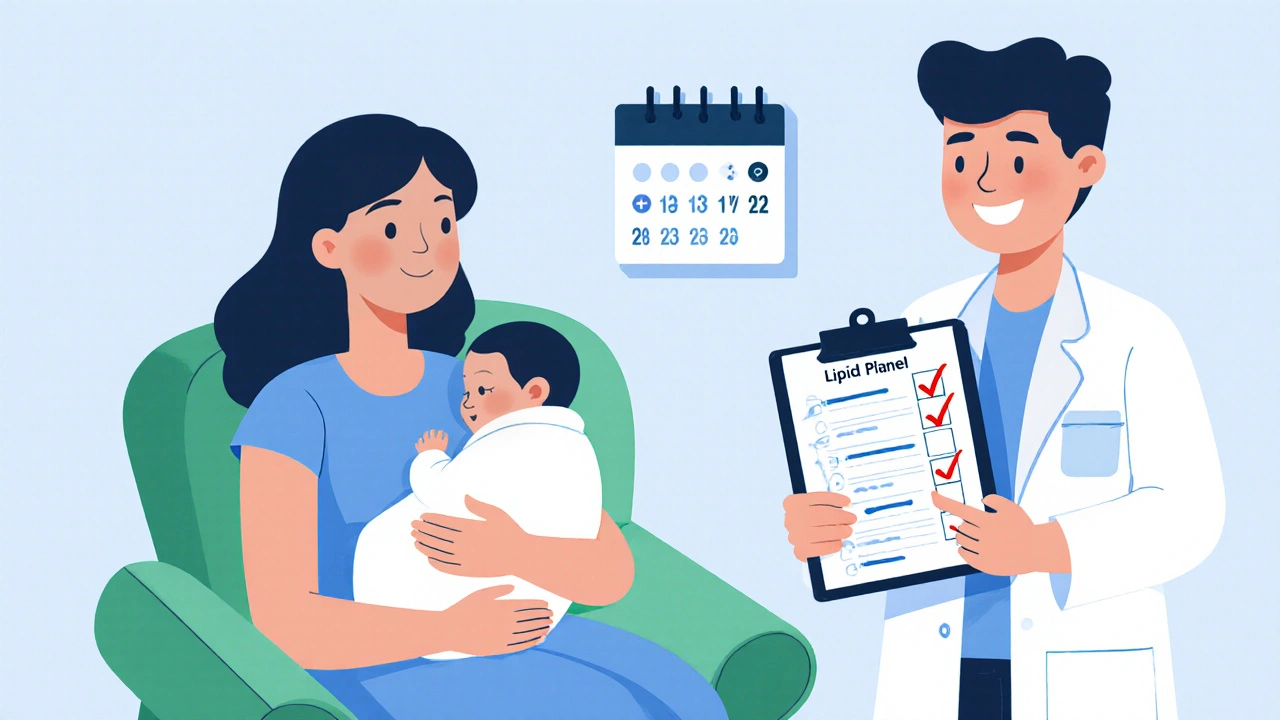Hypercholesterolemia and Pregnancy: Risks, Monitoring, and Safe Management
 Oct, 18 2025
Oct, 18 2025
Pregnancy Cholesterol Risk Assessment Tool
Enter your LDL cholesterol level to assess pregnancy risks and receive tailored management recommendations based on current medical guidelines.
How This Works
This tool uses the 2024 American College of Obstetricians and Gynecologists guidelines to assess your risk level based on your LDL cholesterol value. Remember: these results are for informational purposes only and should not replace professional medical advice.
Your Risk Assessment
Recommended Monitoring Schedule
- Baseline non-fasting lipid panel before 12 weeks
- Repeat testing at 20 weeks if baseline is abnormal
- Late third trimester testing for high-risk cases
When a woman discovers she has hypercholesterolemia while planning a family, the first thought is often: "Will this ruin my pregnancy?" The answer isn’t a simple yes or no. Understanding the specific risks, how to keep a close eye on lipid levels, and which safe strategies work best can turn a scary diagnosis into a manageable part of prenatal care.
What Does Hypercholesterolemia Mean in a Pregnant Body?
Hypercholesterolemia is a condition where total cholesterol levels, especially low‑density lipoprotein (LDL cholesterol), stay higher than recommended. During pregnancy, natural hormonal shifts already push lipid numbers up by 30‑50%, but they usually stay within a safe window. When pre‑existing hypercholesterolemia is present, those numbers can overshoot, raising red flags for both mother and baby.
Key thresholds (based on 2024 American College of Obstetricians and Gynecologists guidance):
- Total cholesterol > 280 mg/dL
- LDL cholesterol > 190 mg/dL
- HDL cholesterol < 40 mg/dL may signal an imbalance
Why High Cholesterol Matters During Pregnancy
Three major risk categories emerge:
- Maternal cardiovascular strain - Elevated LDL can accelerate atherosclerotic changes, increasing the odds of pre‑eclampsia and gestational hypertension.
- Placental insufficiency - Excess cholesterol can deposit in placental vessels, potentially limiting oxygen and nutrients to the fetus, which may lead to intra‑uterine growth restriction (IUGR).
- Long‑term offspring health - Emerging studies (e.g., 2023 Australian Birth Cohort) link maternal hypercholesterolemia with higher childhood LDL levels, setting the stage for early‑onset heart disease.
These risks don’t mean pregnancy is off‑limits; they simply demand a tailored care plan.
How to Diagnose and Track Lipids Safely
Standard fasting lipid panels are discouraged after the first trimester because fasting can trigger hypoglycemia. Instead, use a non‑fasting lipid profile taken between 10 am and 2 pm. Repeat testing schedule:
- Pre‑conception or first‑trimester baseline.
- Mid‑second trimester (around 20 weeks) if baseline is abnormal.
- Late third trimester (34‑36 weeks) for high‑risk cases.
All labs should report HDL cholesterol, LDL, triglycerides, and total cholesterol. Keep a simple chart on the patient’s chart for quick trend spotting.
Nutrition First: Diet Strategies That Really Work
Diet is the cornerstone of any cholesterol‑lowering plan, and pregnancy adds two more priorities: fetal growth and maternal nutrient reserves.
Core recommendations:
- Increase soluble fiber (oats, barley, legumes) - helps bind cholesterol in the gut.
- Swap saturated fats (butter, fatty red meat) for monounsaturated fats (olive oil, avocados).
- Eat two servings of fatty fish per week (salmon, sardines) for omega‑3s, which modestly lower triglycerides and support fetal brain development.
- Limit added sugars and refined carbs - they raise triglycerides and can exacerbate gestational diabetes.
- Stay hydrated; aim for 2‑3 L of water daily to aid lipid metabolism.
For patients who dislike fish, a daily Omega-3 fatty acids supplement (EPA/DHA 500 mg) is safe and effective.

Medication Options: What’s Safe and What to Skip
Statins are the go‑to drugs for lowering LDL in the general population, but they cross the placenta and have been linked to birth defects in animal studies. Current guidelines label them Category X for pregnancy - they must be stopped **before** conception.
Safer pharmacologic alternatives include:
| Medication | Class | Safety Rating | Notes |
|---|---|---|---|
| HMG‑CoA Reductase Inhibitors (Statins) | LDL‑lowering | Category X - contraindicated | Discontinue 3 months pre‑conception. |
| Bile Acid Sequestrants (e.g., cholestyramine) | LDL‑lowering | Category B - generally safe | Can bind fat‑soluble vitamins; supplement A/D/E/K. |
| Omega‑3 Fish Oil (EPA/DHA) | Triglyceride‑lowering | Category A - safe | Avoid high‑dose (>2 g) without specialist advice. |
| Niacin | HDL‑raising / LDL‑lowering | Category C - limited data | Often causes flushing; not first‑line. |
| Fibrates | Triglyceride‑lowering | Category C - use with caution | Reserve for severe hypertriglyceridemia >500 mg/dL. |
When a bile acid sequestrant is chosen, prescribe it at bedtime with a full glass of water, and schedule a vitamin panel at 12‑week intervals.
Exercise and Lifestyle Tweaks That Complement the Plan
Regular moderate‑intensity activity (150 minutes/week) improves HDL and helps control weight gain. Safe options:
- Brisk walking or light jogging (avoid high‑impact if you have joint pain).
- Prenatal yoga - improves circulation and reduces stress‑induced cortisol spikes, which can affect lipid metabolism.
- Water aerobics - low‑impact, great for cardiovascular health.
Encourage patients to track steps with a simple pedometer goal of 7,000‑10,000 steps per day.
Clinical Checklist for Managing Hypercholesterolemia in Pregnancy
- Obtain baseline non‑fasting lipid panel before 12 weeks.
- Review medication list; stop statins ≥3 months pre‑conception.
- Introduce diet plan focusing on soluble fiber, omega‑3s, and reduced saturated fat.
- Consider bile acid sequestrant if LDL >190 mg/dL after lifestyle measures.
- Schedule repeat lipid testing at 20 weeks and 34‑36 weeks.
- Monitor vitamin A/E/D/K levels when using sequestrants.
- Document any adverse events (e.g., gestational hypertension) and adjust plan promptly.
Having this checklist on the clinic’s wall ensures no step slips through the cracks.

When to Refer to a Specialist
Although many cases are manageable in primary care, refer to a maternal‑fetal medicine specialist if:
- LDL remains >210 mg/dL despite maximal diet and safe medication.
- Patient develops pre‑eclampsia, severe hypertension, or signs of placental insufficiency.
- There’s a family history of early‑onset coronary artery disease (<40 years), suggesting possible genetic dyslipidemia (e.g., FH).
Genetic counseling can also be offered for familial hypercholesterolemia.
Post‑Delivery Follow‑Up
After birth, the mother’s lipid profile usually rebounds to pre‑pregnancy levels within 6‑12 weeks. This window is ideal for re‑starting statin therapy if indicated. Breast‑feeding mothers should avoid cholesterol‑lowering meds that are excreted in milk (most statins). A repeat lipid panel at 8 weeks postpartum helps decide long‑term strategy.
Quick Reference Table: Target Lipid Ranges by Trimester
| Trimester | Total Cholesterol (mg/dL) | LDL (mg/dL) | Triglycerides (mg/dL) |
|---|---|---|---|
| 1st (0‑13 wk) | ≤260 | ≤150 | ≤150 |
| 2nd (14‑27 wk) | 260‑300 | 150‑190 | 150‑250 |
| 3rd (28‑40 wk) | ≤300 | ≤190 | ≤250 |
Keeping within these ranges, combined with lifestyle changes, dramatically cuts the chance of complications.
Frequently Asked Questions
Can I breastfeed if I’m on a bile acid sequestrant?
Yes. Bile acid sequestrants are not absorbed systemically, so they do not pass into breast milk in significant amounts.
Do cholesterol levels naturally rise in every pregnancy?
They do increase, but usually stay below 280 mg/dL total cholesterol and 190 mg/dL LDL. Anything above these thresholds warrants closer look.
Is it safe to take a standard multivitamin with a sequestrant?
Choose a chewable or liquid multivitamin taken at a different time of day, and add extra fat‑soluble vitamins (A, D, E, K) if the doctor recommends.
What if my LDL stays high despite diet?
A bile acid sequestrant is the first‑line drug during pregnancy. If LDL remains >210 mg/dL, refer to a maternal‑fetal specialist for possible off‑label therapy.
Should I get an early glucose tolerance test?
Because high cholesterol and gestational diabetes share metabolic pathways, many clinicians order an OGTT at 24‑28 weeks, even if the patient has normal BMI.
By blending careful monitoring, a heart‑healthy diet, safe supplements, and the right medication, most women with hypercholesterolemia can enjoy a healthy pregnancy and give their baby the best start possible.
alex montana
October 18, 2025 AT 20:18Wow!!! You think hypercholesterolemia is just a scary label, but it's a battle you can actually win!!! The hormones already crank your lipids up, then you add a genetic tilt-boom, numbers spike!!! You don't have to panic; you just need a game plan!!!
Wyatt Schwindt
October 23, 2025 AT 13:46I hear you, staying calm and following the checklist helps a lot.
Fabian Märkl
October 28, 2025 AT 05:16Exactly! 🎉 Stick to the diet and safe meds, and you’ll get through it just fine! 💪
Natala Storczyk
November 1, 2025 AT 21:46THIS ISN’T SOME FOREIGN THREAT TO BE IGNORed!!! It’s OUR HEALTH, OUR FUTURE-WE MUST TAKE CHARGE!!!
Karla Johnson
November 6, 2025 AT 14:16When we talk about hypercholesterolemia in pregnancy, we first need to acknowledge that the physiological lipid surge is a normal, yet delicate, adaptation of the maternal body to support fetal development; the placenta demands cholesterol for steroid synthesis, and the growing fetus requires it for cell membrane formation. However, when baseline LDL levels are already elevated, this natural increase can push the values into a range that is associated with vascular complications, making close surveillance essential. The literature from the past decade consistently shows a correlation between maternal LDL above 190 mg/dL and a higher incidence of pre‑eclampsia, which in turn raises the risk for both maternal and neonatal morbidity. Moreover, the deposition of cholesterol in placental vasculature can impair nutrient transfer, potentially resulting in intra‑uterine growth restriction, a concern that cannot be understated. It is also worth noting that offspring exposed to high maternal cholesterol have been observed to maintain higher LDL levels into childhood, suggesting a transgenerational impact on cardiovascular risk. Given these stakes, a multidisciplinary approach that includes obstetricians, dietitians, and, when necessary, lipid specialists, becomes the cornerstone of effective management. The first step is a thorough baseline lipid panel obtained before 12 weeks of gestation, preferably in a non‑fasting state to avoid hypoglycemia. Subsequent measurements at around 20 weeks and again in the late third trimester provide a clear trajectory of lipid trends, allowing for timely interventions. Dietary modifications should prioritize soluble fiber sources such as oats and legumes, replace saturated fats with monounsaturated options like olive oil, and incorporate omega‑3‑rich fish or supplements to modestly lower triglycerides while supporting fetal neurodevelopment. When lifestyle changes are insufficient, bile acid sequestrants can be introduced safely, keeping in mind the need for regular monitoring of fat‑soluble vitamin levels. Statins, on the other hand, must be discontinued well before conception due to their teratogenic potential. Physical activity, tailored to the individual's capacity, should aim for at least 150 minutes of moderate‑intensity exercise per week, with options ranging from brisk walking to prenatal yoga. Finally, any signs of hypertension, abnormal fetal growth patterns, or rapid lipid escalation should trigger an early referral to a maternal‑fetal medicine specialist for possible off‑label therapies or more intensive monitoring. By integrating these strategies, we transform a daunting diagnosis into a manageable component of prenatal care, ultimately safeguarding both mother and child.
Linda A
November 11, 2025 AT 06:46One might consider that the body, in its wisdom, seeks balance; thus, interventions should echo rather than dominate this innate harmony.
Joe Moore
November 15, 2025 AT 23:16Yo, they don’t tell ya that big pharma hides the real cure for cholesterol-just pushin’ pills while they keep us in the loop.
Ayla Stewart
November 20, 2025 AT 15:46Thanks for the detailed guide; I’ll make sure to talk with my doctor about the recommended tests.
Poornima Ganesan
November 25, 2025 AT 08:16Honestly, it’s a bit naive to think a simple chat will cover everything-most practitioners skim the checklist and miss the nuanced interactions between lipid metabolism and gestational hormones, which can drastically alter outcomes if not meticulously accounted for.
Emma Williams
November 30, 2025 AT 00:46Good point, a thorough review is definitely important.
Stephanie Zaragoza
December 4, 2025 AT 17:16Your summary is comprehensive; however, it would benefit from emphasizing the timing of vitamin supplementation when using bile‑acid sequestrants-this detail is critical!!!
James Mali
December 9, 2025 AT 09:46Looks solid 👍 but could use fewer buzzwords.